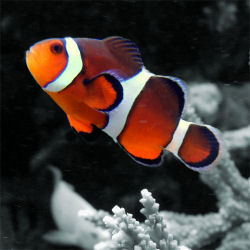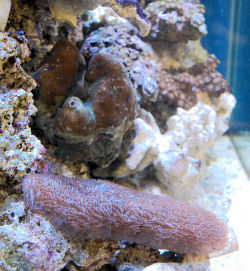Saltwater Care Guide
A simple saltwater aquarium is very similar to a freshwater aquarium.
Crushed coral or Seaflor grade reef sand by Caribsea should be used as substrate. Either should be rinsed thoroughly before placing in the aquarium as they are quite dusty.
Temperature control can be achieved with normal aquarium heater and thermometer. The temperature should be stable at 78 degrees.
Filtration can be accomplished with a regular power filter and the addition of a few pieces of live rock. The live rock will help establish biological stability along with being a food source and a natural decoration.
The water of course must be saltwater. This can be achieved by using de-chlorinated tap water or filtered water such as reverse osmosis. A good quality sea salt can then be added such as Instant Ocean, Red Sea or Tropic Marin. You need to mix the saltwater to a specific concentration. You can measure this with a hydrometer. A specific gravity of 1.021-1.023 will be good for most animals. Let newly mixed saltwater stabilize for 24 hours before introducing to live animals. NWTF sells premixed saltwater. Bring your own container.
A fish only saltwater aquarium has no special lighting needs. Run lights no more than 8 hours a day and watch carefully for excess algae growth. Algae outbreaks are probably one of the biggest problems saltwater aquarists run into. Prevention is easier than getting rid of an outbreak.

Saltwater fish are generally more sensitive than freshwater fish so care should be according. Generally you keep fewer animals in a saltwater aquarium. Adding one fish at a time is the general rule. Testing the water each time to make sure parameters such as ammonia, nitrite, nitrate, Ph and alkalinity are within safe limits. Jungles 6in1 Quick dip test strips are a good choice. You can test these yourself or have NWTF test them for you free of charge.
Saltwater animals have varied diets and should be fed accordingly. Several frozen foods from San Francisco Bay can fill the need. Consult your salesperson when purchasing your fish as to their dietary needs.
Water changes should be performed once every two weeks. A 10% water change vacuuming the gravel is generally adequate. Replace with newly mixed saltwater. Top off for evaporation using de-chlorinated tap water or reverse osmosis water in between water changes. Check specific gravity weekly to make sure it is within safe limits.
Reef Tank Care Guide
Reef tanks require most all of what saltwater fish only tanks need with the addition of a few other items.

Reef tanks require more live rock. 1-2 pounds per gallon is a good start. Past that its up to your aesthetics. Be sure to stack the rock in a manner that makes for good circulation openings through the rock. Water circulation is key to a stable reef aquarium.
Circulation can be achieved using submersible power heads such as Koralia brand power heads. A turnover of 10 to 30 times per hour is typical.
A protein skimmer is another item needed for a reef aquarium. These are foam fractionators . It is a device that blends air and water together to create a foam that gathers in a collection cup. If operating correctly the foam is a dark tea colored smelly substance. This is dissolved organics that typical power filters fail to remove.
Lighting is a huge part of reef aquariums along with being the most confusing. Depending on what types of corals you desire to keep will weigh greatly on what lighting you will need. It can be as basic as power compact lighting to as high end as metal halide or Solaris L.E.D lighting systems. Each type of lighting has its pluses and its minuses. Some are very hot requiring extra cooling for the tank water while others are expensive. On top of this there are now moonlights available so that you can see the nighttime habits of your animals. A visit with your NWTF salesperson will help decide which system best fits your needs.
Reef aquariums contain corals which may require supplements such as Calcium, iodine, strontium and molybdenum. There are several products that can help with this. One of the best for basic reef aquariums is Purple-up. The addition of DT’s phytoplankton can also be beneficial.
